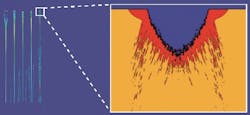HALO project results: Optimized beam profiles for laser machining
The Fraunhofer Institute for Laser Technology (Fraunhofer ILT; Aachen, Germany) says that lasers for cutting applications have roughly 50% of the material processing market worldwide, with the most dominant application being the precise, flexible 2D cutting used to produce nearly any contour in sheet metal blanks. At the same time, completely new cutting methods such as perforations or the precise shaping of glass displays for mobile devices are on the verge of entering industrial production. As part of the European Union's HALO project (High power Adaptable Laser beams for materials processing; http://halo-project.eu/), scientists at Fraunhofer ILT have optimized the laser beam's intensity for various applications and will present their HALO project results at LASER World of Photonics 2015 in Munich.
RELATED ARTICLE: Real-time thermopile sensing /beam profiling optimizes laser output
For sheet metal, laser performance up to 8 kW is the industrial technology standard and even permits the cutting of metal sheets up to 50 mm thick. Lasers have also demonstrated suitability for cutting other materials such as semiconductors, glass, plastics and composites. Tool wear, which can lead to decreased quality when using conventional cutting methods, does not occur with laser cutting. However, the cut edges of laser-machined components are still rougher than those of milled metal components, for example. This is partly because the laser beam often does not have the right form needed to achieve the best result for the application in question.
A laser beam with a typical Gaussian intensity distribution is not necessarily the ideal tool for every application. For example, while this beam distribution is suitable for quickly cutting a sheet 1 mm thick at a relatively high quality, a sheet with a thickness of 1 cm requires a broader beam with greater intensity distribution at the edges. The latest research activities of HALO are focused on defining the right laser beam for cutting material of various types and thicknesses and tapping the resulting potential.
Since September 2012, an international consortium consisting of nine research institutes and industrial companies including TRUMPF and Synova has been working to develop application-specific beam formations within HALO. Under the leadership of Gooch & Housego, the project participants are customizing the laser beam’s intensity distribution for each individual use case. Ultimately, the laser systems are to be equipped so that users can perform practical tests. Experts from Fraunhofer ILT see enormous potential in this regarding cost cutting and processing speed, even as product quality improves.
Fraunhofer ILT's Macro Joining and Cutting group and the Modeling and Simulation group have been studying laser cutting for more than 25 years. In their work, the researchers apply sophisticated diagnostic methods (high-speed videography of the cutting process, streak image technology for melt flow analysis, and schlieren techniques for visualizing the flow of cutting gas) and evaluation methods (meta-modelling, QuCut simulation of ripples). Now, as part of the HALO project, selected applications will be used to examine how the laser beam should be constructed to achieve optimal cutting results.
Fraunhofer ILT's Modeling and Simulation group is contributing significantly to these efforts by applying findings from computer simulations to help optimize laser processes. The group first simulates the cutting processes on the computer, before calculating the intensity distribution of the ideal laser beam for the individual application. It then designs the optical components based on this information.
The results of the HALO project will presented to the public for the first time as part of the "European Research on Laser Based Technologies" Forum at LASER World of Photonics 2015:
Professor Wolfgang Schulz, Nonlinear Dynamics of Laser Processing NLD, RWTH Aachen University
"HALO--Real Time Adjustment of Laserbeam Properties for Optimum Process Results"
Hall A2, Stand 250
June 25, 2015, from 13:00 to 13:20 hours
In addition, Fraunhofer ILT experts will be showing laser beam cutting processes for different materials in the macro and micro area as well as simulations of these processes at LASER World of Photonics (Munich, June 22 – 25, 2015), Fraunhofer Joint Stand--Hall A3, Stand 121.
SOURCE: Fraunhofer ILT; http://www.ilt.fraunhofer.de/en/publication-and-press/press-release/press-release-2015/press-release-2015-05-12.html

Gail Overton | Senior Editor (2004-2020)
Gail has more than 30 years of engineering, marketing, product management, and editorial experience in the photonics and optical communications industry. Before joining the staff at Laser Focus World in 2004, she held many product management and product marketing roles in the fiber-optics industry, most notably at Hughes (El Segundo, CA), GTE Labs (Waltham, MA), Corning (Corning, NY), Photon Kinetics (Beaverton, OR), and Newport Corporation (Irvine, CA). During her marketing career, Gail published articles in WDM Solutions and Sensors magazine and traveled internationally to conduct product and sales training. Gail received her BS degree in physics, with an emphasis in optics, from San Diego State University in San Diego, CA in May 1986.
